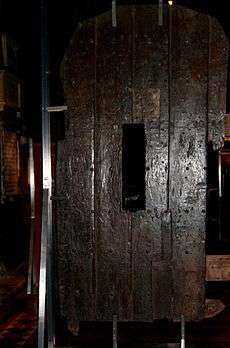Butler–FitzGerald dispute

A dispute between two leading dynastic families of medieval Ireland, the Butlers, (Earls of Ormond) and the FitzGeralds, (Earls of Kildare) was resolved in 1492 by a brave act and a magnanimous response. Black James, nephew of the Earl of Ormond, fleeing from FitzGerald's Geraldine soldiers, took sanctuary in the chapter house of St. Patrick's Cathedral in Dublin. Though he had the upper hand, with his soldiers surrounding Black James and his men, Gearóid Mór FitzGerald, Ireland's premier earl, wished to end the bloody feud between both families. He pleaded with Black James through the Chapter House's oak door to meet him to negotiate a peace. Black James rebuffed all requests. FitzGerald ordered his soldiers to cut a hole in the centre of the door. Then, having explained how he wished to see peace between the families, the Earl thrust his hand and arm through the hole to shake hands with Black James. It was a risky venture; any of Black James's heavily armed men could have hacked the Earl's arm off; however, James shook his hand and ended the dispute.
"Chancing one's arm"
Though the Chapter House has long been demolished, it was originally located in the South Transept of St Patrick's Cathedral. The door of the Chapter House is now on display in the cathedral's north transept where it is now known as the Door of Reconciliation.
This event is locally credited as an etymology of the term to chance one's arm, which means "to perform an action in the face of probable failure".[1] Scholars consider this to be a false etymology, as:
- The term is not recorded in print till 1889, almost 400 years later
- The protagonists spoke Early Modern Irish rather than English
Latin and Middle French were also spoken by some Gaelic chieftains of those times.
- Other more plausible etymologies exist, for example non-commissioned officer's stripes being lost through demotion.
- In the British Navy during the Napoleonic Wars, the expression "chance one's arm" arose because it was the responsibility of the cannon loader, when a charge misfired or a ball became stuck in the barrel, to insert his arm to remove the projectile so the cannon could be reloaded. Occasionally, a "hang-fire" would occur, with the cannon discharging late; taking the loader's arm with it.